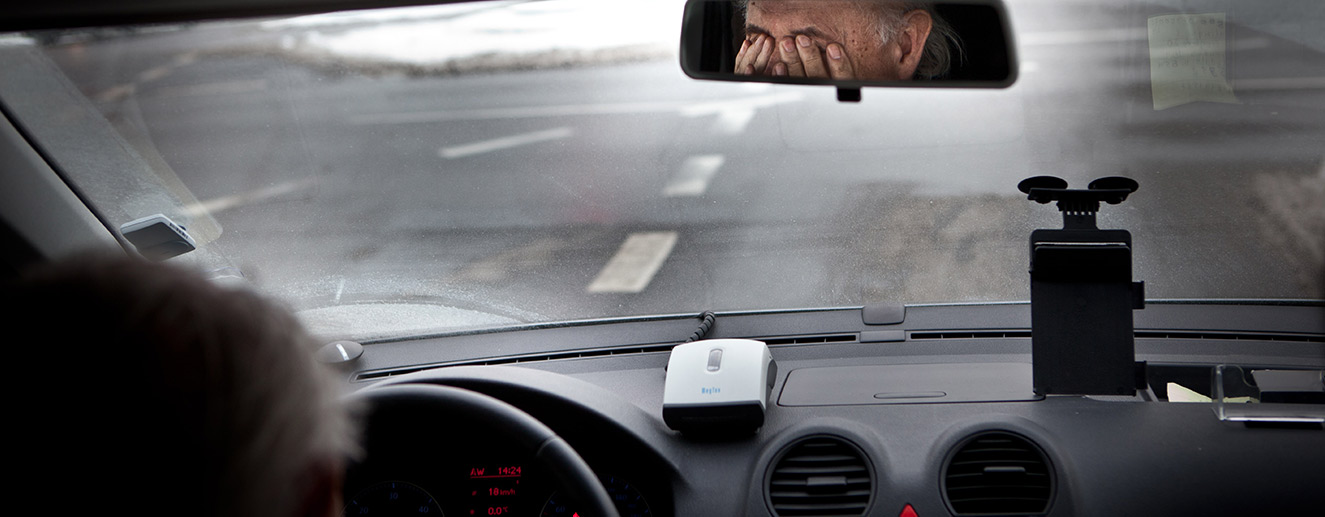The National Sleep Foundation states that half of the adult drivers in the United States admit to getting behind the wheel while feeling tired or sleepy. Shockingly, 20% have stated they have fallen asleep behind the wheel at some point! Driver fatigue leads to accidents and even loss of life as it is an extremely serious threat to road safety. Unfortunately, signs of fatigue are sometimes tough to identify, so a driver might not even know if they are fatigued.
In this article, we learn about:
- What driver fatigue means and its causes
- Signs of driver fatigue and effect
- Times of day when the risk of driver fatigue is highest
- How to overcome and manage driver fatigue?
- Who is at risk for drive fatigue?
- Taking breaks to combat driver fatigue
- Know more about driver fatigue monitor
- Reducing fatigue for long-distance trips and long-haul driving
- Find out if adaptive cruise control can reduce fatigue
What is Driver Fatigue?
One of the most common hazards of road safety is driver fatigue. It not only poses a risk to the driver but to drivers in other vehicles and pedestrians too. To put it in a nutshell, driver fatigue is a state of extreme tiredness, lethargy, or weariness, which impacts focus. Drivers have less time to react to dangers since their concentration is impaired. When on-road decision-making capabilities are compromised due to fatigue, it poses serious danger to road safety.
What causes Driver Fatigue?
While driver fatigue can happen to anyone for a number of reasons, here are the most common ones. Take a look:
- Physical exhaustion – feeling tired, weary, and lethargic.
- Long working hours, along with Inconsistent or disruptive work schedules – the body and mind both feel exhausted, so focus is dangerously impaired.
- Not getting sufficient sleep over multiple days puts excessive stress on drivers, which can lead to periods of micro-sleep, loss of concentration, etc.
- Inadequate rest periods or breaks during long journeys mean drivers aren’t well-rested.
- Disorders like sleep apnea, where the person stops breathing during sleep. It leads to poor sleeping patterns.
- Medications that cause drowsiness and lethargy, which is bad when the driver is on the job.
What are the signs of Driver Fatigue?
Did you know that 20% of fatal road accidents in Australia are related to driver fatigue? It is important to identify these troubling signs immediately – take a look:
Constant yawning
When drivers feel tired, one of the very first signs is they yawn frequently.
Driving erratically
Sticking to your lane is a must while driving. If the driver is wandering outside the lines, it is a definite sign of tiredness. Watch out for fluctuating speed, tailgating, and not following traffic signs, as well.
Head bobbing
When you are jerked awake by your head hitting your chest, it is a sign of micro-sleep and is common with driver fatigue. Even if it lasts for a few seconds, it could be dangerous on the roads.
Daydreaming
Disconnected or wandering thoughts can cause drivers to go off-route without having any recollection. It isn’t like micro-sleep, but the driver is unaware of their surroundings and basically “zones out”.
Impairment of focus
The driver is unable to concentrate on the road ahead due to feeling tired, which means a slower reaction time in case a hazard occurs. When the driver finds it tough to keep their eyes open, it spells trouble.
Odd behavior
Are drivers behaving irritably? Are they driving in a restless manner, and becoming impatient? These are definite signs of driver fatigue.
What can fatigue do to a driver?
If someone is awake for 17 hours, their concentration is impaired to the same level as a person with a blood alcohol concentration of 0.05. Drivers shouldn’t take their eyes off the road for even a second! Fatigue impacts attention, which directly affects mental processing and decision-making abilities. Thus, they will react to hazards much slower than usual. And if they lapse into micro-sleep as mentioned above, without realizing it, the risk is greatly multiplied. Drivers are often unaware they are slipping in and out of periods of wakefulness. This lack of awareness can lead to major incidents. A fatigued driver takes much longer to notice an unexpected hazard on the road, so response time is much more. If a driver misjudges speed and distance, due to a split-second delay, it can have devastating consequences!
What are the high-risk times for driver fatigue?
While driver fatigue can happen anytime, the risks of it are the highest between 2 am and 6 am, and also in the afternoon between 2 pm and 4 pm. The reason is that the internal body clock tends to induce sleepiness during these times.
How to overcome driver fatigue? Can driver fatigue be managed?
The obvious answer to overcoming fatigue is by sleeping! No one should drive when they are tired or feeling drowsy. Here are some ways to overcome driver fatigue:
- Set limits on overtime and maximum allowable consecutive shifts.
- Sufficient staff should be available so drivers don’t buckle under extreme workloads.
- Offer comprehensive training regarding sleep health and fatigue management.
- Try to develop a sleep disorder screening and management program.
- Make sure drivers get enough breaks during extended work shifts.
- Encourage self-reporting by providing supervisors and drivers with checklists for fatigue symptoms.
- Peer monitoring practices for such symptoms among co-workers should be implemented too.
- Keep tabs on data from in-vehicle monitoring systems – it helps to identify signs of possible fatigue, like lane departures, irregular speeding, etc.
- Wearables and in-cabin monitoring devices can be used to send alerts and notify fleet managers of driver fatigue.
- Incident investigators should be trained, so they can determine the role of fatigue if any accident occurs, and even in near-miss incidents.
Who is at risk for driver fatigue?
Practically everyone is at risk for driver fatigue, but the following groups can be classified as “high risk”:
- Young drivers from 18 to 24.
- Shift workers, especially those manning the graveyard shift. Those working rotating shifts have to be careful.
- People with extremely long work hours. Those with more than 60 hours should exercise great caution.
- Drivers with undiagnosed or untreated sleep disorders.
- Commercial vehicle drivers, especially long-haul drivers, are on the road for hours at a time.
How often should you take a break from driving to avoid driver fatigue?
It is necessary to stop for at least 15 minutes, every two hours. Drivers can use this time to rest and relax, so they can resume the journey with a fresh and clear mind, along with a sharp focus. Those driving long distances or for extended periods of time should take a longer break of a minimum of half an hour.
What is a driver fatigue monitor?
A driver monitor is a device that offers extensive in-cabin monitoring and is immensely useful for detecting signs of driver fatigue. It tracks eye and facial movements with the aid of sensors, to understand if the driver is feeling tired, or is totally alert behind the wheel. If it senses an irregularity, an alert is immediately sent to the supervisor, who can take corrective action. The drivers are notified too, so they can rectify the issue. Anstel has recently collaborated with Cipia to offer a robust driver and fleet monitoring platform that helps to assess driving patterns, correct troubling behavior, spot signs of fatigue, and ensure road safety.
What can fleet managers do to solve driver fatigue issues for long-haul driving?
Fleet managers bear the ultimate responsibility of protecting drivers and ensuring road safety for others as well. They have to strategically solve driver fatigue problems, so they don’t affect long-haul driving and lead to consequences.
Provide safety training
According to the Law, it is imperative to undertake driver safety training, to ensure all drivers of heavy vehicles or commercial vehicles are aware of how to keep themselves and others on the road safe, from the effects of fatigue. Drivers should be able to identify the signs of fatigue and know how to deal with them. Educate them about the risks involved, so they realize the seriousness of the situation.
Don’t put excessive strain on drivers
Even fleet managers have targets and deadlines to meet, which often puts extra pressure on drivers. However, there is a legal mandate on the hours of service and required rest periods. These are the basic standards that should be followed, so encourage drivers to adhere to these rules. They should try to avoid long stretches of driving whenever possible, and take frequent breaks so they are rested and alert.
Use fleet management software
While driver monitoring systems help to detect signs of driver fatigue inside the vehicle, fleet management software can give a clearer insight into driving behavior. It can sense troubling patterns like sharp braking, speeding, tailgating, rapid acceleration, and more. The information is transmitted in real-time, so appropriate action can be implemented quickly. The software helps to keep tabs on driver hours and provides alerts on potential violations before they occur. It lets fleet managers allocate workload more evenly, so drivers aren’t overstressed, which lowers the risk of fatigue setting in.
How can you reduce driver fatigue during long trips?
The danger is compounded during long trips, as the distance and time increase by a great deal. It is imperative for the driver to be alert and focused at all times. Here are some ways to deal with driver fatigue:
Driving time should be restricted
On average, a person shouldn’t drive more than 8 hours in a single day – after this, tiredness starts to set in. However, drivers are often allotted 10 or even 12-hour shifts. Try to limit their driving time to 8 hours if possible, with plenty of breaks in between. Each break should help to reenergize. As mentioned, a 15-minute break is a must every couple of hours.
Plan breaks and rest stops
Apart from taking breaks, drivers should also rest when traveling long distances. However, they should be able to take longer breaks too, if it helps to stay focused. There are public rest stops on major highways, where they can eat, relax, and freshen up, before resuming the journey.
Don’t forget to assign a backup driver
If possible, assign another driver as a backup. What if one driver feels ill on the way? The backup driver can take over and even get medical help. It is also a good idea to ensure that drivers keep switching throughout the journey till they reach the destination. This way, no one will be overly tired or succumb to micro-sleep.
How much do driver assists like adaptive cruise control help to reduce driver fatigue?
Adaptive cruise control basically senses the distance of another vehicle in front and adapts the cruise control speed to maintain a safe distance from it. Drivers can set the interval as to how close or far away they want to be from the vehicle in front. They can even choose the farthest setting so the gap is much wider. However, this intelligent feature still requires that the driver is alert and in total control of the vehicle. It acts as an additional layer of protection, and shouldn’t be a substitute for responsible driving.
Parting Thoughts:
Driver fatigue is much more than a little tiredness or feeling sleepy. It can often lead to life or death situations, because a driver’s attention should be on the road at all times, so nodding off, getting distracted, or driving wearily, is simply not an option. Fatigue and sleep deprivation leads to both physical and mental health complications that adversely impact productivity. Combating driver fatigue is a must, so that focus and concentration aren’t affected, they are able to fulfill targets, and your business runs smoothly.

 Global
Global Australia
Australia India
India




